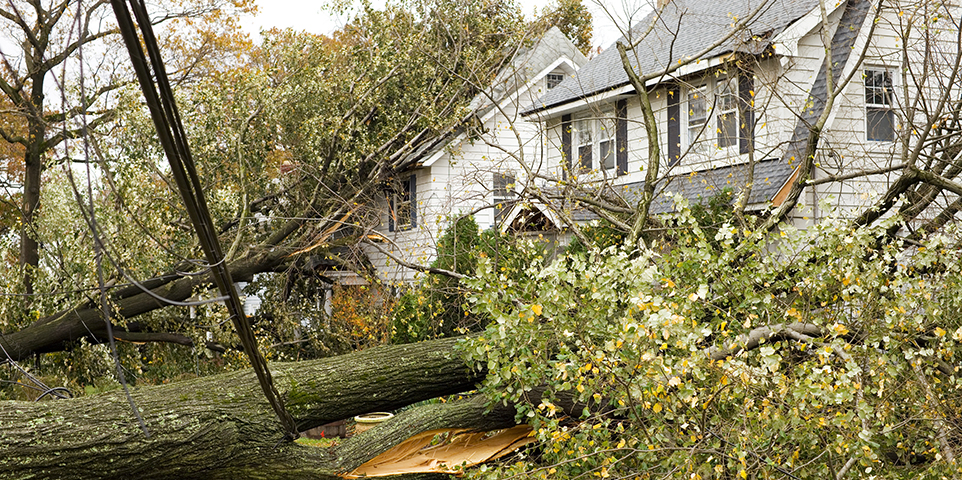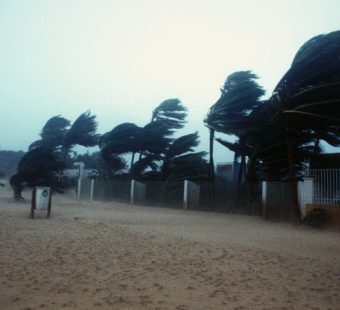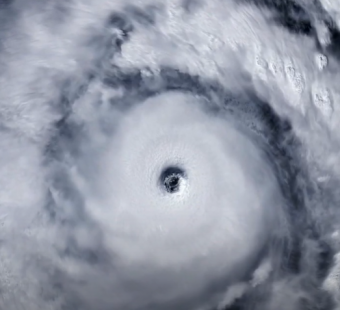
Facts + Statistics: Hurricanes
The official Atlantic hurricane season runs from June through November, but occasionally storms form outside those months. September is the most common month for hurricanes making landfall in the U.S., followed by August and October, according to an analysis of 1851 to 2015 data by the National Oceanic and Atmospheric Administration. No hurricanes made U.S. landfall before June and after November during the period studied.
2019 Hurricane Season
Barry became a tropical storm on July 11 in the Gulf of Mexico and strengthened to Category 1 hurricane status on July 13 as it moved toward the Louisiana coast. It made landfall later that day near Intracoastal City, Louisiana as a tropical storm. Barry brought heavy rain and wind to the north central Gulf coast, and remained over Louisiana as it weakened into a tropical depression on July 14. Other areas impacted were the Mississippi River Valley and the southeastern states of Alabama, Florida and Mississippi. Catastrophe modeling companies estimated that private flood and wind insured losses would total between $300 and $600 million.
Dorian became a tropical storm on August 24 and strengthened to hurricane status on August 28 near St. Thomas, U.S. Virgin Islands. By August 30, Dorian had strengthened to a Category 4 storm and became an historic Category 5 storm on September 1 as it made landfall over the Abaco Islands in the Bahamas and later on Grand Bahama Island. Dorian continued to pound the Bahamas into September 3 with devastating wind, rain and storm surge. Catastrophe modelers estimate industry insured losses resulting from Hurricane Dorian in the Caribbean will be between $1.5 billion and $6.5 billion, including reinsurance and National Flood Insurance Program (NFIP) losses.
Dorian weakened to Category 3 and moved close to the Florida east coast by September 4 bringing storm surge resulting in beach erosion and flooding, and later affecting South and North Carolina. On September 6, Dorian weakened to a Category 1 storm and made landfall at Cape Hatteras, North Carolina bringing wind, storm surge and flooding to North Carolina and Virginia on its way to New England. Dorian made landfall over Nova Scotia on September 7 as a Category 1 hurricane. Catastrophe modelers estimate industry insured losses in the United States from Dorian to total between $500 million and $1.6 billion. This range includes reinsurance and NFIP losses.
Humberto formed near the northwestern Bahamas and became a tropical storm on September 14 and became a hurricane on September 15 southwest of Bermuda and peaked at Category 3 as it approached the island on September 16. Humberto become post-tropical by September 20 and produced large swells along the east coast of the United States, causing dangerous rip tides. Hurricane Jerry formed around the same time, becoming a hurricane on September 19. Tropical Storm Imelda brought an estimated 16 to 24 inches of rain to Beaumont and Houston, Texas and heavy rain over a large section between southwestern Louisiana and Texas by September 20.
2018 Hurricane Season
During the 2018 Atlantic hurricane season 15 named storms formed. Eight of those storms became hurricanes and two of those, Florence and Michael, became major storms, Category 3 and above. Florence, the third hurricane of the season reached Category 4 status as a slow-moving storm that brought hurricane-force winds, life-threatening storm surge, and freshwater flooding. Florence made landfall along the southeastern coast of North Carolina as a Category 1 storm and brought significant storm surge flooding to portions of eastern North Carolina. It produced rainfall that exceeded 20 inches along the North and South Carolina border, and in some parts of North Carolina exceeded 30 inches, a state record. The previous record was 24 inches caused by Hurricane Floyd in 1999. In South Carolina, a new record was reached when rainfall reached almost 24 inches. Florence directly caused 22 deaths in the United States, including 15 in North Carolina, 4 in South Carolina and 3 in Virginia, according to the National Hurricane Center (NHC). Catastrophe modelers have estimated that insured losses from Hurricane Florence would range from $2.0 billion to $5.5 billion, excluding National Flood Insurance Program losses.
Hurricane Michael became a strong Category 5 storm on October 10 and made landfall near Mexico Beach, Florida, in the Florida Panhandle. Hurricane Michael was the strongest hurricane to ever hit the Florida Panhandle and the second known category 5 landfall on the northern Gulf Coast, according to the National Oceanic and Atmospheric Administration. It was the first Category 5 storm to make landfall in the United States, after Hurricane Andrew in 1992. Michael caused 16 deaths in the United States: seven in Florida, five in Virginia, three in North Carolina and one in Georgia. Catastrophe modelers estimated that insured losses from Hurricane Michael could range from $6 billion to $11 billion. As of October 25, 2019, the Florida Office of Insurance Regulation reported that insured losses from Michael in Florida had reached $7.44 billion, comprised of residential and commercial property, private flood and business interruption insurance, and miscellaneous coverages. There were 149,773 claims made through October 25, with 89.4 percent of those claims closed. About 16,000 claims remained open.
2017 Hurricane Season
The Atlantic hurricane season of 2017 broke several records, as 17 tropical storms formed, with 10 of them becoming hurricanes. Six hurricanes became major storms, Category 3 and above—Harvey, Irma, Jose, Lee, Maria and Ophelia. Two hurricanes, Irma and Maria, reached Category 5 strength. The 2017 Atlantic hurricane season was the first time three Category 4 hurricanes—Harvey, Irma and Maria—made landfall in the United States and its territories in one year, according to the Insurance Information Institute (I.I.I.).
On August 25 Hurricane Harvey made landfall in Texas as a Category 4 storm. Harvey was the first major hurricane to hit the U.S. mainland since Hurricane Wilma in 2005, and the first Category 4 hurricane to affect Texas since Hurricane Carla in 1961. The last time a hurricane made landfall in Texas was in 2008 when Hurricane Ike, a Category 2 storm, struck the state. Hurricane Harvey dropped about 50 inches of rain in portions of the Greater Houston area and the upper Texas coast, breaking records. On August 30 Harvey made landfall west of Cameron, Louisiana, as a tropical storm. With at least 68 direct deaths reported in Texas, Harvey was the deadliest U.S. hurricane since superstorm Sandy in 2012, and the deadliest to hit Texas since 1919, according to the National Oceanic and Atmospheric Administration (NOAA). Loss estimates are not yet available from the Property Claims Services (PCS) unit of ISO. The Insurance Information Institute estimates that insured losses from Hurricane Harvey totaled between $18 billion and $20 billion in dollars when it occurred, making it the fourth costliest hurricane to hit the United States, excluding flood damage covered by the federally administered National Flood Insurance Program (NFIP).
Hurricane Irma made landfall in the Lower Florida Keys as a Category 4 hurricane on September 10, and a second landfall in Florida on Marco Island as a Category 3 hurricane. Hurricane Irma was one of the most powerful and costliest hurricanes in the Atlantic Basin, and the first major hurricane to make landfall in Florida since Hurricane Wilma in 2005. At its peak it was a Category 5 storm and was the strongest hurricane to make landfall in the U.S. since Katrina in 2005. According to NOAA Irma brought record storm surge to parts of the Southeast coast, including Jacksonville, Florida, with significant coastal flooding extending into the Carolinas. Irma caused 10 direct deaths in the United States, three in the U.S. Virgin Islands, and the remainder on mainland United States, according to NOAA. Loss estimates are not yet available from the Property Claims Services (PCS) unit of ISO. The Insurance Information Institute estimates that insured losses from Hurricane Irma totaled between $20 billion and $24 billion in dollars when it occurred. By late 2019, claims were still being closed, some of which had been reopened, and insurers were still dealing with assignment of benefit claims (see Chapter 9, Litigiousness). Reinsurance News, which documents latest loss estimates from a range of sources, reports that Hurricane Irma caused insured losses of $32 billion.
Maria became a Category 5 hurricane on September 18 and made landfall as a Category 4 hurricane in Puerto Rico. Maria was the strongest hurricane to make landfall in Puerto Rico since a Category 5 hurricane hit the island in 1928. Maria caused 65 official direct deaths and catastrophic damage to much of the island and up to 37 inches of rain, with widespread flooding and mudslides, according to NOAA. The government of Puerto Rico later estimated that the number of deaths was 1,427 due to delayed or interrupted health care, and raised that tally to 2,975 after a study was conducted by George Washington University. Loss estimates are not yet available from the Property Claims Services (PCS) unit of ISO. The Insurance Information Institute estimates that insured losses from Hurricane Maria totaled between $25 billion and $30 billion in dollars when it occurred. Hurricane Maria was the second costliest hurricane to hit the United States, excluding flood damage covered by the federally administered NFIP, and was surpassed only by Hurricane Katrina, which caused about $52 billion in insured losses in 2018 dollars.
Costliest U.S. Hurricanes
The chart below shows insured losses for the top 10 costliest hurricanes in the United States in dollars when they occurred and in 2018 dollars, adjusted for inflation. Insured losses for the catastrophic hurricanes of 2017—Maria, Irma and Harvey—are represented as a range because factors such as the severity of the losses and the fact that the storms happened in rapid succession, straining resources for the claim settlement process, have hindered the development of final estimates. The amount of insured losses for Irma in Florida are still to be determined; claims have been reopened, and business interruption losses for all three storms are still being settled. The Insurance Information Institute has developed the ranges after studying estimates from catastrophe modelers and other organizations. To date, losses for 2018 Hurricanes Florence and Michael are still preliminary.
More from the Triple-I



